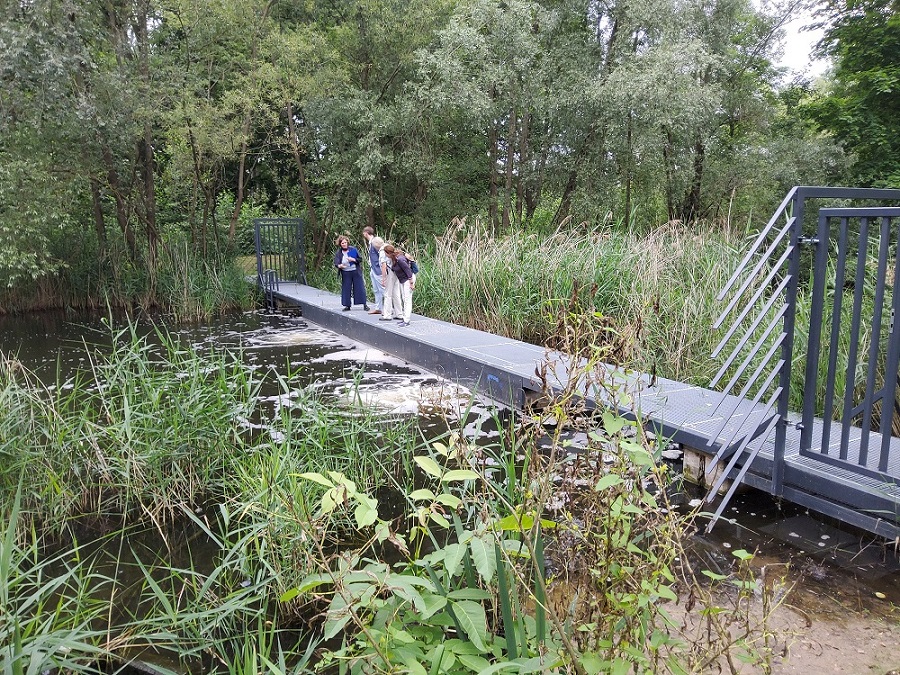Recreation area Dransemündung in Pankteal - relaxation and nature conservation

The mouth of the river “Dransemündung” in the district of Zepernick in the municipality of Panketal has been redesigned as a near-natural experience and recreation area. A Kneipp entry into the river Panke, play and sports equipment and a picnic area invite visitors to linger. When redesigning the area, nature conservation and water protection were always taken into account.
The area between the Straße der Jugend, the Panke and the Dranse in the district of Zepernick is one of the last green places in the heart of Panketal. Against the backdrop of the steady influx of new residents and the increasing sealing of areas, the desire grew in the municipality to offer a local and natural recreational opportunity in the countryside. The approximately three-hectare area was redesigned in such a way that it invites people to linger and offers opportunities for play and exercise for all generations and families. In the process, it was also important to preserve and enhance existing green spaces and the flora and fauna – also against the backdrop of climate change.
Next to the Kneipp entry into the Panke, a picnic area was created at the mouth of the Dranse river. There are now also hammocks as a way to relax. A barrier-free carousel was built for people with limited mobility. On the Berlin-Usedom cycle path, which runs through the grounds, bicycle stands were set up, a fitness track with sports and play equipment and new paths including lighting were created. Among others, schoolchildren will also benefit from this, because in the future they will cross the area on their way to a new gymnasium that is being built not far away. In addition, the facility will also be used for natural history lessons. The construction of the entire redesign was largely financed by funding from the European Regional Development Fund (ERDF). The project was also part of the Urban Development Competition of the State of Brandenburg.
Harmony between humans and nature
In addition to creating recreational and exercise areas, the measure also focused on nature conservation, water issues and water management. Contaminated sites were removed, trees and hedges were planted and resting areas for amphibians were created. The special feature of the site is that the Zepernick baths used to be located here. Remains of the concrete pool are still in the ground. Over the years, a unique biotope developed in it, which could be preserved in the course of the conversion. Especially in the summer months, however, it often threatened to “tip over” due to the lack of fresh water. Through comprehensive water monitoring, the lack of oxygen can now be counteracted by aeration with a circulation pump and the addition of nitrate. If the water threatens to tip over, countermeasures are initiated immediately. The constant monitoring of temperature, water level and oxygen content by the municipality of Panketal is unique and thus a model for many other municipalities that would like to see similar upgrading for their water bodies.
For further information, visit panketal.de
The area between the Straße der Jugend, the Panke and the Dranse in the district of Zepernick is one of the last green places in the heart of Panketal. Against the backdrop of the steady influx of new residents and the increasing sealing of areas, the desire grew in the municipality to offer a local and natural recreational opportunity in the countryside. The approximately three-hectare area was redesigned in such a way that it invites people to linger and offers opportunities for play and exercise for all generations and families. In the process, it was also important to preserve and enhance existing green spaces and the flora and fauna – also against the backdrop of climate change.
Next to the Kneipp entry into the Panke, a picnic area was created at the mouth of the Dranse river. There are now also hammocks as a way to relax. A barrier-free carousel was built for people with limited mobility. On the Berlin-Usedom cycle path, which runs through the grounds, bicycle stands were set up, a fitness track with sports and play equipment and new paths including lighting were created. Among others, schoolchildren will also benefit from this, because in the future they will cross the area on their way to a new gymnasium that is being built not far away. In addition, the facility will also be used for natural history lessons. The construction of the entire redesign was largely financed by funding from the European Regional Development Fund (ERDF). The project was also part of the Urban Development Competition of the State of Brandenburg.
Harmony between humans and nature
In addition to creating recreational and exercise areas, the measure also focused on nature conservation, water issues and water management. Contaminated sites were removed, trees and hedges were planted and resting areas for amphibians were created. The special feature of the site is that the Zepernick baths used to be located here. Remains of the concrete pool are still in the ground. Over the years, a unique biotope developed in it, which could be preserved in the course of the conversion. Especially in the summer months, however, it often threatened to “tip over” due to the lack of fresh water. Through comprehensive water monitoring, the lack of oxygen can now be counteracted by aeration with a circulation pump and the addition of nitrate. If the water threatens to tip over, countermeasures are initiated immediately. The constant monitoring of temperature, water level and oxygen content by the municipality of Panketal is unique and thus a model for many other municipalities that would like to see similar upgrading for their water bodies.
For further information, visit panketal.de

